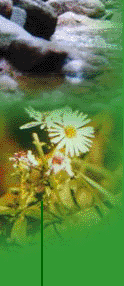

Paper
presented
at
The 2000 American Dairy Science Association and the American Society of Animal Science
Joint Annual Meeting July 24 - 28, 2000 Baltimore Convention Center Baltimore, Maryland
The following is the text of a paper presented by Sarah Bedgar
and authored by S.E Bedgar, T.M Moreland, D.L Owings, and J. Saunders
"Good afternoon, my name is Sara Bedgar, and I am currently a senior studying, Animal Science, at the University of Maryland at College Park.
Today I am going to be talking to you about FlyCracker as a natural house and stable fly larvae control, and its duration f effectiveness as a larvicide.
Currently there's a major fly problem in the United States. Flies are a serious and costly problem for most animal-producing, facilities. Infestation by stable flies and houseflies causes significantly lower rates of gain and losses in milk production. Fly infestation causes dairy and beef cow producers to lose over $190 million annually. In fact, newest information shows that insect resistance is increasing, therefore, so are losses due to flies.
The fly problem continues, as manure and organic material serve as the principal breeding areas for both stable and houseflies. In fact, a single calf hutch with straw bedding can produce 25,000 to 40,000 stable and house fly larvae in one summer.
Previous methods for stable and house fly control include chemical insecticides. These insecticides continue to be the main method for controlling fly populations on animal-producing farms. Insect resistance, along with environmental and safety concerns, have promoted research for safe-chemical and non-chemical methods of fly control.
As you are probably wondering, what is FlyCracker? FlyCracker's active ingredient is 2-Hydroxy1,2,3-propanetricarboxylic acid. It consists of free flowing, translucent crystals, and its carbohydrate technology kills fly larvae within 24 hours. FlyCracker's mode of action is that it is absorbed by the insects intestinal membrane. The carbohydrate remaining in the gut, cause severe fluid imbalance and the insect dies from dehydration and/or disruption of organs. But unlike pesticides, which kill with biochemical effects, FlyCracker's mode of action is physical.
There are advantages to using, a larvicide over a pesticide. Fly larvae will not build up resistance to FlyCracker, and by killing female larvae before they reach adult stages, FlyCracker eliminates a potential breeding population.
Previous successes of FlyCracker include studies done by Miller and Pickins, in which FlyCracker, in a liquid form, was demonstrated to be effective against fly larvae in poultry pens and cattle bedding.
There are many advantages to using, FlyCracker. No known toxic effects were found in mammals for these compounds in tests conducted by Biospherics and others.
It's environmentally safe because of the complete biodegradability of Carbon Dioxide and water. It's identified by the EPA as minimum risk, and it is unlikely that resistance to the physical action of FlyCracker will develop. We tested in these two studies, FlyCracker as a larvicide, FlyCracker in a granular form, but we did not test any environmental issues.
The first study conducted in the summer of 1998, where FlyCracker, in a calibrated shaker container, was used in calf hutches and pen pack bedding. It was applied at rates of 0, 15 and 30 grams per square foot of bedding area, and sample areas of 6 inches wide by 6 inches Ion-, by 2 inches deep, were collected and counted following Williams, et a], 1980 standard.
However, at the University of Maryland, we devised a system where we used the shaker cans to distribute the FlyCracker within the bedding and the samples were collected using a spatula and aluminum cans. The samples were frozen and then the larvae were counted. The FlyCracker for the first study was sprinkled around the perimeter six inches of the calf hutches and maternity bams at the University of Maryland's Dairy Research Facility.
Samples were collected once every 3 or 4 days along the treatment area and dry matter of bedding was measured using a Koster moisture tester. Results of the first study showed, that dry matter above 60% was optimum, and with dry matter of less than 60%, the FlyCracker was degraded too quickly and was not successful.
There was a second study conducted in 1999, the purpose of the second study was to determine the required frequency of application and to completely test the effectiveness of FlyCracker under challenging conditions. Methods and materials of the second study, included 20, 4.5ft x 4.5ft calf pens Bedding consisted of 25% sawdust and 75% straw, approximately. The bedding was measured with a Koster tester before the study began to assure the dry matter was above 60% and the bedding, was maintained at above 60% dry matter.
For the second study, the pens were allowed to develop adequate organic matter of more than I 00 larvae per sample, and this insured an optimal fly breeding, environment and ample larvae infestation. FlyCracker was applied with a calibrated shaker container at rates of 25 grams per square foot. Treatments were made every 7 days, and samples were collected weekly using the same technique as the first study.
Results of the second study showed, that when applied at a rate of 25g per square at seven-day intervals, FlyCracker was a completely effective larvicide for fly control in bedding, with dry matter greater than 60%. Over-all results include that test results indicated that FlyCracker is more effective in bedding comprised of over 60% dry matter. Areas where the moisture content increased above 50% resulted in less larvae control, when treated weekly, and FlyCracker gave 94-1 00% control, when 25g per square foot was used weekly in dry bedding or pen packs.
Advantages of FlyCracker include, it's biodegradable, it's in an easy to use granular form, and it's safe for the environment, animals and people.
In conclusion, based on our small-scale studies, FlyCracker cannot be a sole source of pest management on a farm. However, in granular form, FlyCracker can be easily and effectively used in an integrated pest management program.
Thank You."